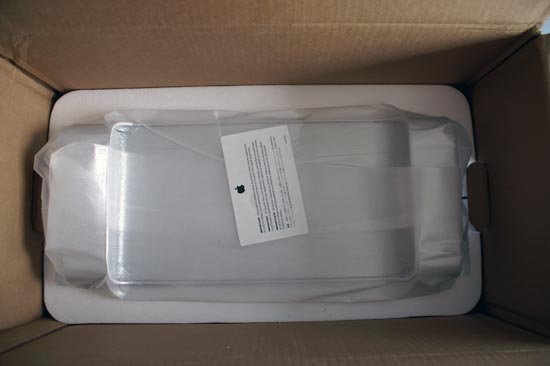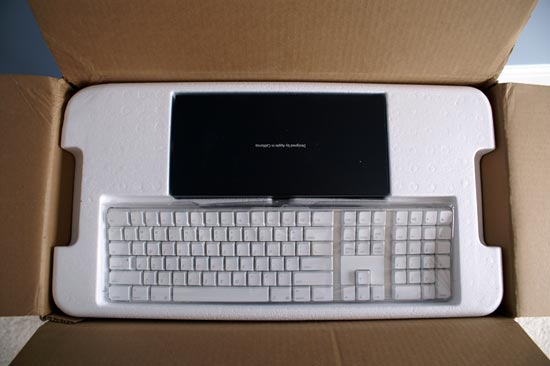Apple's Mac Pro - A True PowerMac Successor
by Anand Lal Shimpi on August 16, 2006 12:27 PM EST- Posted in
- Mac
It's here, it's quiet and it's fast; we got our Mac Pro on Friday and spent every day since taking it apart, using it and benchmarking it. There's far too much to include in one review, so we're breaking it up into three parts. We've already published the first part of our coverage last week, where we discussed the specifications of the new system as well as inadvertently turned the article into a primer on the implications of the FB-DIMMs that the Mac Pro uses. So if you want a brief two-page technical overview of FB-DIMMs, you'll want to consult that article.
Part two is what you're reading today; here we're going to be looking at the Mac Pro as a Mac (mostly) and compare the performance of two speed grades (2.0GHz and 2.66GHz) to the outgoing PowerMac G5. We'll also take the thing apart and give you a nice tour in pictures of the new chassis.

PowerMac G5 (left), Mac Pro box (guess where)
The third and final part will have two focuses - DIY upgrades (e.g. swapping CPUs and sticking in your own FB-DIMMs) as well as performance under Windows XP. Apple just released an updated version of Boot Camp with support for the Mac Pro that should hopefully address some of the serious performance issues we ran into while running Windows XP on our machine. Give us a week and you'll have part 3 to peruse at your leisure.
With our plan of attack laid out, it's time to dive into the Mac Pro and we'll start where very few Mac users like to: at its price. In the past we've generally shied away from getting too caught up in the price debate, because honestly if you're buying a Mac, you're doing so because of the OS and assigning value to that is difficult. Some users are content with other OSes and see no value in OS X, and to them the value in a Mac is simply the total cost of the components that make up the machine. At the same time there are other users who prefer OS X and thus find additional value in a system that is able to run that OS. Regardless of which camp you fall into, the Mac Pro is competitively priced. We'll let the table below do the talking:
|
Apple Mac Pro |
Dell Precision Workstation 490 |
Home Built Config |
|
|
CPU |
2 x Xeon 5150 (2.66GHz) |
2 x Xeon 5150 (2.66GHz) |
|
|
Memory |
2x 512MB DDR2-667 FB-DIMMs |
2x 512MB DDR2-667 FB-DIMMs |
|
|
Graphics |
GeForce 7300 GT |
Quadro NVS 285 |
|
|
Hard Drive |
250GB SATA 3Gbps |
250GB SATA 3Gbps |
|
|
Optical |
SuperDrive (DVD+R DL/DVD+-RW/CD-RW) |
16X DVD+-RW |
|
|
Notes |
Free 17" LCD, had to add sound card, mouse and 1394a card |
Includes Supermicro X7DAE motherboard priced at $474; does not include price of OS, case or power supply |
|
|
Price |
$2499 ($2299 with educational discount) |
$3110 |
$2390 |
The Dell is clearly more expensive, although you can knock off $100 - $200 thanks to the bundled LCD (unfortunately Dell gives you $0 credit if you remove the monitor from your order). We're able to come close with our own configuration by shopping at Newegg and other vendors through our shopping partner, but note that the $2390 total does not include an OS, case or power supply.

If you're in the market for a dual socket dual core Xeon workstation, Apple's Mac Pro is definitely a bargain. The only real issue here is that not everyone needs or can adequately use a dual socket Xeon workstation, in which case you can argue that there's better value in a cheaper single socket Core 2 system. Unfortunately Apple does not offer any such system, which leads us to believe that we'll either eventually see the introduction of a cheaper single socket Mac Pro or maybe even a new product line simply called the "Mac" that uses desktop Core 2 processors instead of their Xeon counterparts.
Bottom line? The default configuration of the Mac Pro is priced very competitively for what you get; whether or not you need what you get is a different discussion entirely.












96 Comments
View All Comments
Anand Lal Shimpi - Wednesday, August 16, 2006 - link
Could you show me how to get Dell to take $149 off for the monitor? Whenever I try to configure it if I select the "No Monitor" option it lists a cost of $0, meaning I don't gain or lose anything.The Dell protection plan is truly enterprise class however the point of the comparison was to look at things from a purely hardware/cost of components perspective, which is how these Mac vs. PC price comparisons are usually done. Once you go above and beyond that then you get into this slippery slope argument of how much you should tack on for the price of being able to run OS X, etc...
Take care,
Anand
delta53 - Wednesday, August 16, 2006 - link
The "they" was referring to Apple namely at the WWDC6, no offence Anand. The option is given under the Medium and Large business section, but your point is well taken that exact price is impossible in that section.Keep up the good reports,
Kyle
Furen - Wednesday, August 16, 2006 - link
I was under the impression that Cinebench had very light memory usage. It looks to me that what will make or break Woodcrest's "power efficiency" is going to be FBDIMM power so perhaps loading up the ram will paint slightly different numbers...TamarinMonkey - Wednesday, August 16, 2006 - link
Now that we can run both OSX and XP on the same hardware, I'd be interested to see some of the benchmarks run on both OSs and see how they do. Any plans to do this in a future article?~Tam~
retrospooty - Wednesday, August 16, 2006 - link
I am pretty sure this has been done, and OSX has been found to be lacking, especially in 3d games. The speed advantage of PC over MAC was not that Intel/AMD were so much faster than IBM G4, then G5, but the OS and drivers are much finer tuned.Tegeril - Wednesday, August 16, 2006 - link
It was definitely not so much about the OS/Drivers being finer tuned in regards to 3D gaming. It was definitely a DirectX versus OpenGL issue.psychobriggsy - Thursday, August 17, 2006 - link
More specifically, Apple's OpenGL implementation on PowerPC was/is severely lacking.I wonder if the Intel Mac OS X drivers are better - i.e., the ATI/Nvidia drivers ported to Mac OS X.
Konq - Monday, September 11, 2006 - link
I just played WoW last night on my Quadro 4500-equiped Mac Pro. An ATI version should be similar. I was in a 40 man raid for my guild. This thing screams in OS X. I get 30-40 fps in a crowded IF, 50-100 fps flying, and I peaked at 135 fps looking at the sky. All at 1920x1200. The drivers sure have improved and I think are better on intel. I have a 2.3 Ghz dual core G5 and this is twice as fast even thought the G5 had a 7800 GT card. Oh - and I never noticed the fans spin up during the raid even though I had low sound volume.Rumor has it that OpenGL will be much improved when it goes multithreaded in 10.4.8. We will see. :)
Konq - Monday, September 11, 2006 - link
I forgot to mention: the Mac Pro loaded the WoW AQ40 instance in about 2 seconds! Faster even the second time. I can't express how impressed I am with this machine.As a side note, I used Office in Rosetta, and it is as fast as my G5. Maybe 4GB of RAM helps here but I was worried after reading Anands' report.
Pirks - Wednesday, August 16, 2006 - link
Please use XP x64 benchmarks as well, since it's uberinteresting to see how both 64-bit OSes from MS and Apple compete. XP 32-bit is okay, but a bit boring.